- Not many years ago if you were planning a trip to Africa to see wildlife, Kenya would be near the top of the list, if not number one.
- Then violent riots in late 2007 and early 2008 leaving a thousand dead tarnished the country’s image abroad.
- When calm and stability returned, Kenya was again open for tourism, and it’s true that most travelers were quick to forget: articles earlier this year announced that even with the global economic crisis Kenya was expecting tourism growth.
- However, a new disaster may not be so quickly overcome.
In part one we explored the humanitarian impact of the drought, now we look at how the drought—and other crises—are affecting Kenya’s wildlife.
Not many years ago if you were planning a trip to Africa to see wildlife, Kenya would be near the top of the list, if not number one. Then violent riots in late 2007 and early 2008 leaving a thousand dead tarnished the country’s image abroad. When calm and stability returned, Kenya was again open for tourism, and it’s true that most travelers were quick to forget: articles earlier this year announced that even with the global economic crisis Kenya was expecting tourism growth. However, a new disaster may not be so quickly overcome.
As reported in our first article on the topic, the drought striking East Africa has left millions hungry, littered landscape with dead and dying livestock, evaporated lakes and streams, and pressed farmers from fields into slums.
However, the disaster has also blasted the usually drought-prone wildlife of East Africa. Elephants, hippos, antelopes, buffalo, rhinos, even flamingoes have all been impacted. But while devastating, it turns out the drought is only the latest in a long list of troubles for Kenya’s wildlife.
Steady decline for decades
Before the drought Kenya’s wildlife, which brings in 70 percent of the nation’s important tourism trade, was already in trouble.
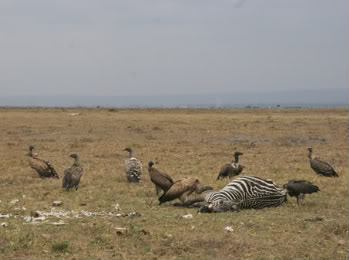 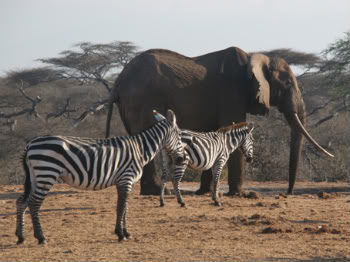 Top: vultures may have plenty to eat during droughts, but their numbers have been severely depleted by poisoning from the agricultural pesticide Furadan. Bottom: emaciated zebras and elephant. Photos courtesy of Wildlife Direct blogs Lion Guardians. |
The country has been hemorrhaging between 4 to 5 percent of its wildlife every year. Since 1985 the nation has lost one-third of its wildlife according to the government’s Department of Remote Sensing and Resource Surveys (DRSRS). This is largely due to habitat loss, but also human-animal conflicts, including poaching and poisoning have played a role—one that is increasing.
Kenya’s wildlife is not only vital to the region, but to the world: the East African country has the largest biodiversity of big animals in the world.
Despite the importance of the wildlife for Kenya’s ecosystems and economy, critics say that the government has done little to address the steady decline in wildlife.
Kenyan Wildlife Services (KWS) runs all of Kenya’s parks and reserves, but the organization has no power in Kenya’s many private reserves, and when 65 percent of the nation’s wildlife live in unprotected areas trends that occur outside of parks have a large impact.
In the past KWS has refuted the claims of any wildlife decline. Recently, Corporate Communications Manager for KWS Paul Udoto went one step further, saying that the organization cannot verify whether or not Kenya’s wildlife is in decline.
But everyone else appears to accept that the decline is not only obvious, but massive.
Drought
The current drought has only exacerbated the situation: killing animals through lack of water and food, and increasingly complex human-wildlife interactions.
Nairobi National Park may be in the most trouble of all Kenya’s national parks. The reserve’s main water source Athi River has completely dried up.
“Many crocodiles, hippos and fish have died,” Dr. Joseph Ogutu, an ecologist with the International Livestock Research Institute based in Nairobi, told the East African Standard.
While Nairobi National Park has the largest population of wild ostrich in the world, the great birds have not nested this year, and wildlife managers think this is because the cattle have supplanted their habitat.
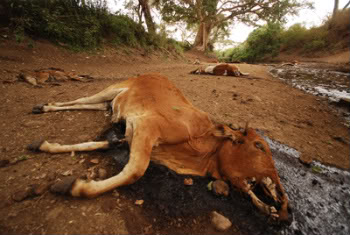 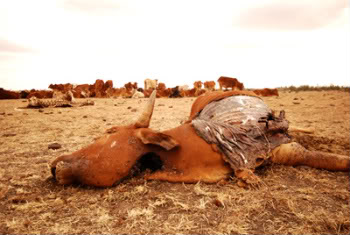 Dead cattle are a common sight in some areas of Kenya now. Photos courtesy of Wildlife Direct. |
Cattle herders desperate to provide their starving herds with food have illegally invaded the park; cutting through fences, they lead their livestock in at night. The invading cattle are picking the pasture—meant for wildlife—clean.
But disease carried by the cattle may be the biggest concern, including foot and mouth, East Coast fever, and anthrax. Already some of these diseases have shown up in wildlife: Nairobi National Park lost two rhinos to anthrax and some antelopes have been found with foot and mouth.
There have been many reports that the majority of cattle are not in fact from the country’s suffering pastoralists, but rather belong to wealthy Kenyans and politicians.
Tsavo East and Tsavo West National Parks have seen their own incursions of cattle. Park rangers stated that the large numbers of cattle are forcing elephants out of the park and into the surrounding countryside where they are likely to destroy remaining crops and increase the likelihood of human-animal conflict.
The drought has also forced the locals to exploit the park, explains Daniel Woodley who heads the KWS team at Tsavo West: since the local community’s crops didn’t come this year, “their reliance on other natural resources increased: timber, honey, charcoal, which is probably the main cash crop in drought period, bush meat, and illegal fishing.” He estimates there are 200,000 head of cattle coming into Tsavo West.
No park has been spared. “Amboseli is extremely dry […] The place is littered with dead wildlife; buffalo, zebra, wildebeest and sadly elephants are dying too,” writes the conservation organization Lion Guardians on their blog at Wildlife Direct.
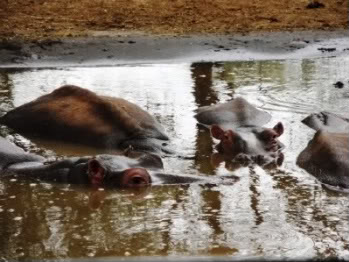 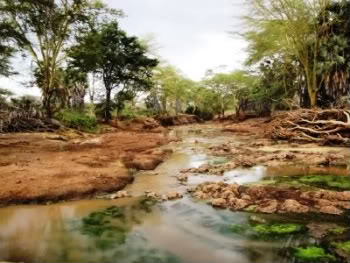 Top: starving hippos take shelter in increasingly shallow waters to avoid heat, drought on the Tsvao River. Bottom: The shrinking Tsavo River. Photos courtesy of Wildlife Direct blog Bushmeat in Kenya |
Even hippos are starving. Fifteen hippos died in Tsavo West in mid-August due to nothing to eat.
“It has been a challenge to remove the carcass. The other hippos are very defensive, one in particular – we suspect him to be a son of the dead hippo,” KWS Ranger Edward Njuguna told the AFP.
Hippos depend on grass under water and on the shoreline for subsistence but the drought has left little to no food for them. Cedric Khayale, a KWS research scientist, told AFP that due to the drought other animals are eating the hippo’s normal food sources. This means that hippos have to travel further from their water pool to find sources of food, but the large mammal can only cover an area of approximately seven square kilometers before perishing from exhaustion and hunger.
The situation grew so bad in Tsavo West that KWS began feeding the hippos as though they were in a zoo According to Njuguna, every other day KWS gives their resident hippos four bales of hay to keep them alive.
But it’s not just large mammals that are suffering. The flamingoes of Lake Nakuru, numbering from thousands to near a million depending on the season, have run out of fresh water. Lake Nakuru’s water is too salty for the flamingoes to drink and the streams and rivers of freshwater going to the lake have all dried up. To help out the world famous flamingo population, KWS has set up artificial water points.
The situation in parts of the country has become so dire there have even been reports of camels dying.
Poaching and poison
Elephants are not immune to the drought. In twelve months, there have been 38 elephant deaths in northern Kenya directly linked to drought conditions.
Iain Douglas Hamilton of Save the Elephants told BBC that it is of particular concern that old matriarch elephants are among the casualties: “you lose the memory banks. That’s the lessons the matriarchs have learned from their own mothers about things like where to go for water. If a matriarch dies before those lessons have been handed down, and the new head of the family makes a mistake in a drought like this, it’s potentially very serious for the entire group.”
But it’s not just drought that is devastating elephant family groups—after years of relative calm, poaching is on the upswing. Elephants, along with black, and white, rhinos, are being targeted in numbers that have set conservationists aback. Rhino poaching—both in Asia and Africa—has hit a fifteen year high.
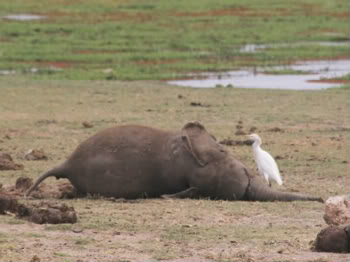 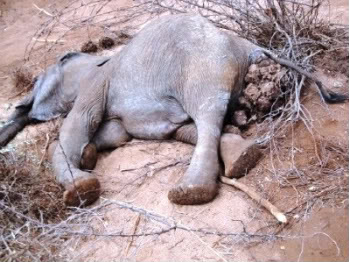 Top: baby elephant lies dead in Amboseli. Bottom: Elephants are succumbing to drought, but they are also being killed for their ivory to be sold largely to Japan and China. Some are even being killed for bushmeat. Photos courtesy of Wildlife Direct blogs Lion Guardians and Bushmeat in Kenya. |
Some conservationists are saying that this sudden poaching epidemic is due to a decision by CITIES last year to sell off a stockpile of ivory from Botswana, South Africa, Namibia, and Zimbabwe to Asia. Since the sale, ivory prices have risen in Asia and conservationists worry that instead of satiating the demand for ivory in Asia, the sale has only increased it.
Conservation legend in Africa, Richard Leakey, has warned that poaching may be occurring at an unprecedented scale. Worryingly, he has said that he believes some in KWS may be involved in the poaching.
A senior warden at KWS told that East African Standard that he agreed with Leakey.
“Our rangers have become demoralized and demotivated, it is true they are abetting the wildlife poaching especially the big mammals like elephants and the rhino.”
The hardship brought on by the drought may also be making new poachers. Some believe that Masaai herdsmen, who have lost all their cattle to the drought, are turning to poaching simply to make money to put food on the table.
“The herdsmen, faced with starvation and extreme poverty cannot resist the extra shilling that they are being enticed with by Chinese nationals working in a nearby construction project,” writes Iregi Mwenja on his Bushmeat Blog at WildlifeDirect. “It is evident from the crime scene and the carcass that these elephants were killed using spears in a struggle that must have required several men to execute. These are not the ivory poachers we have known for decades who mostly use automatic weapons to kill elephants.”
Usually poachers kill an elephant solely for its ivory tusks. However, recent reports state that some poachers are also cutting off the feet and trunks of elephants to be sold as bushmeat—a rarity, but perhaps a sign of the desperate hunger in some regions.
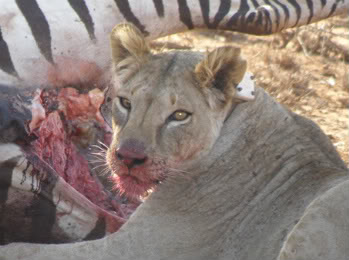 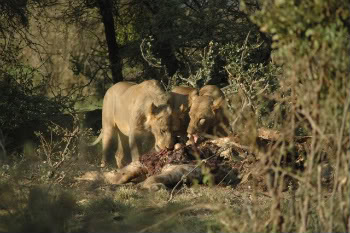 Lions are in the boom times in terms of food during the drought, but they face other ever-present threats that have depleted their numbers significantly. Photos courtesy of Wildlife Direct blogs Lion Guardians and Ewaso Lions. |
People are targeting more than elephants. One would think in the drought situation with antelope and wildebeest dying from thirst, lions would be in boom times, but while there may be plenty of meat for lions, the great cats remain imperiled from a different source than starvation.
Kenya’s lions have been declining for decades. Biologists point to two reasons: loss of habitat and poisoning. Although illegal, the pesticide Furadan is easily found in Kenya and is an apt lion-killer. If livestock is killed by a lion, herders will often add Furadan to the corpses which poisons anything that feeds on it, including hyenas, jackals, vultures, and of course its target, lions. KWS says that the lion population has been dropped by 100 cats every year for the best seven years.
The situation has become so bad that a recently KWS stated that the king of cats may only 20 years left in Kenya if drastic action isn’t taken.
Others disagree: Laurance Frank with the cat conservation group Panthera said that he thinks lions may only have a decade left in Kenya.
Despite pressure from various conservation groups, Furadan is still accessible and cheap. Farmers will also use it to kill birds they consider pests by the truckloads.
The future
Many Kenyans are saying that the dire situation facing Kenya’s wildlife—and people—has been exacerbated by long standing government ineptness and poor priorities.
Environmentalists are pointing fingers at policies that allow business interests to use exorbitant amounts of water, such as the flower trade for Holland. They say such policies are essentially gambling away water resources for Kenya’s people, livestock, and wildlife for commercial flower production.
 October rains have come to places in Kenya: here a rare rainbow over the landscape. Photos courtesy of Wildlife Direct blog Ewaso Lions. |
Environmentalist, social activist, and Nobel Peace prize winner, Wangari Maathai, has said that the government’s laissez faire attitude toward the Mau Forest Complex, which has been highly degraded and deforested, is a good example of mismanagement leading directly to rainfall decline and the lack of drought-resistant water sources.
In a nation where drought is common—though rarely so severe—many are saying the government should have been more prepared. Global trends—both El Nino and global warming—are also said to be exacerbating the drought which by all reports is the worse 2000.
Whatever the multiplicity of causes, one has to wonder, at a time when the Kenyan government has not even been able to feed its own people, can and should the government do anything for suffering wildlife?
It is true that without wildlife Kenya’s tourism pretty much collapses—and so does the nation’s ecosystems, already strained as they are. While these large animals draw people from around the world to take their photos, they also affect the landscape in subtle—and not so subtle—ways. But there is another important attribute to Kenya’s wildlife: it seems impossible to escape the pride Kenyans feel toward their beautiful landscapes and stunning species. It’s not just show for tourists; it’s something less tangible, but perhaps far more important.
The crisis will pass—parts of the country are rejoicing at rainfall in the last week—but then the nation will be left with hard choices about how to change (or not change) its policies to better safeguard the country in the future. Will wildlife or even environmental preservation be apart of this discussion?
One has to ask the question: is Kenya really Kenya without its wildlife?
A special thanks to WildlifeDirect for photos and continuous coverage of the drought.